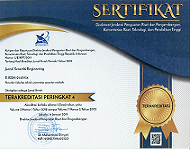Pengaruh Intensitas Cahaya dan Kecepatan Pengadukan Terhadap Degradasi Limbah Laundry Menggunakan Fotokatalis ZnO-Zeolit dari Limbah Baterai Zn-C
Keywords:
Photocatalysis, ZnO, Zeolite, Laundry Wastewater, Zn-C Battery Waste, Photodegradation, Stirring Speed, Light IntensityAbstract
Wastewater from laundry activities contains various pollutants such as phosphates, surfactants, and dyes that can harm the environment. This study proposes an innovative solution by utilizing waste from Zn-C batteries as a raw material for synthesizing ZnO photocatalysts. Photocatalysis is an effective method for degrading pollutants, and using ZnO from battery waste provides a more economical and sustainable alternative. To enhance photocatalytic performance, ZnO is combined with zeolite as a supporting material to modify its electronic structure, especially to lower the band gap energy, thereby increasing its ability to break down harmful compounds in laundry wastewater. The ZnO-Zeolite photocatalyst was tested using 0.75 grams of catalyst with 100 mL of laundry wastewater for 60 minutes. Variations in stirring speed (200–800 rpm) and UV lamp intensity (15 Watt, 20 Watt, and without UV) were applied. Photocatalytic performance was evaluated by measuring pH, COD, and TSS after the degradation process. The best performance was obtained at 20 Watt UV light and 600 rpm stirring speed, resulting in COD of 60 mg/L, TSS of 31 mg/L, and pH 6.62. Lower efficiency at higher stirring speeds occurred due to excessive turbulence, causing particles to resuspend and reducing degradation effectiveness.
References
[1] G. Crini, D. Lacalamita, E. Lichtfouse, N. Morin-Crini, C. Liu, L. D. Wilson, L. A. Picos-Corrales, M. A. Akhere, M. Sotiropoulou, C. Bradu, and C. Mongioví, “Characterization and treatment of industrial laundry wastewaters: A review,” Environmental Chemistry Letters, Aug. 2024, doi: 10.1007/s10311-024-01770-y.
[2] J. Arora, A. Ranjan, A. Chauhan, R. Biswas, V. D. Rajput, and S. Sushkova, “Surfactant pollution, an emerging threat to ecosystem: Approaches for effective bacterial degradation,” Journal of Applied Microbiology, vol. 133, pp. 1229–1244, 2022
[3] S. R. Smith, Phosphates: Impact on the Environment. Cambridge, UK: Cambridge University Press, 2020.
[4] A. O. Babatunde, Y. Q. Zhao, A. J. O’Neill, and J. A. O. Sullivan, “Adsorption and coagulation in wastewater treatment: A review,” Progress in Agricultural Engineering Sciences, vol. 6, no. 1, pp. 1–16, 2010, doi: 10.1556/Progress.6.2010.1.1.
[5] C. B. Ong, L. Y. Ng, and A. W. Mohammad, “A review of ZnO nanoparticles as solar photocatalysts: Synthesis, mechanisms and applications,” Renewable and Sustainable Energy Reviews, vol. 81, pp. 536–551, Jan. 2018, doi: 10.1016/j.rser.2017.08.020.
[6] C. Zhu and X. Wang, “Nanomaterial ZnO synthesis and its photocatalytic applications: A review,” Nanomaterials, vol. 15, no. 6, p. 682, 2025, doi: 10.3390/nano15060682.
[7] H. S. Mansur, L. A. Gonçalves, A. A. P. Mansur, and R. M. L. Costa, “Enhanced Photocatalytic Activity of ZnO Nanoparticles Grown on Porous Silica Microparticles,” Applied Nanoscience, vol. 7, pp. 421–431, 2017, doi: 10.1007/s13204-017-0626-3.
[8] Iazdani, F., Nezamzadeh-Ejhieh, A. The photocatalytic rate of ZnO supported onto natural zeolite nanoparticles in the photodegradation of an aromatic amine. Environ Sci Pollut Res 28, 53314–53327 (2021). https://doi.org/10.1007/s11356-021-14544-8
[9] E. W. Diyanthi, E. P. Hadisantoso, and R. Fitriyani, “Regenerasi fotokatalis nanopartikel ZnO dari limbah baterai untuk penanganan metil violet,” Prosiding Seminar Nasional Kimia, pp. 19–33, 2023.
[10] F. Shihab and E. Hadisantoso, “Sintesis dan karakterisasi nanokomposit ZnO/NiFe₂O₄ dari limbah baterai menggunakan metode solid state sebagai fotokatalis zat warna metilen biru,” Gunung Djati Conference Series, vol. 15, no. 1, pp. 23–32, 2022.
[11] L. Yang and Z. Liu, “Study on light intensity in the process of photocatalytic degradation of indoor gaseous formaldehyde for saving energy,” Energy Conversion and Management, vol. 48, no. 3, pp. 882–889, 2007
[12] Murillo-Acevedo et al., "Initial approximation to the design and construction of a photocatalysis reactor for phenol," ACS Omega, vol. 4, pp. 19605–19613, 2019
[13] T. A. Al-Dhahir, E. E. AL-Abodi, T. M. Al-Saadi, and L. Issam, "ZnO nanoparticles: Synthesis and crystal structure study," Wasit Journal for Science & Medicine, vol. 7, no. 3, pp. 87-95, 2014.
[14] M. Julita, M. Shiddiq, dan M. Khair, "Determination of Band Gap Energy of ZnO/Au Nanoparticles Resulting in Laser Ablation in Liquid," *Indonesian Journal of Chemical Research*, vol. 10, no. 2, pp. 83-87, 2022
[15] Amri dan M. Pranjoto Utomo, M. Si, "Preparasi dan Karakterisasi Komposit ZnO-Zeolit untuk Fotodegradasi Zat Warna Congo Red," Jurnal Kimia Dasar, vol. 6, no. 2, pp. 29-36, 2017.
[16] S. Wibowo, K. N. Aulia Azhar, and D. A. Sahanaya, “Fotodegradasi Methylene Blue Menggunakan Fotokatalis TiO2/Zeolit,” Warta Akab, vol. 47, no. 1, pp. 17–21, 2023.
[17] Oktavia Wulandari, "Studi Pengaruh Konsentrasi ZnO pada Zeolit terhadap Degradasi Methylene Blue secara Fotokatalitik," Skripsi, Fakultas Matematika dan Ilmu Pengetahuan Alam, Universitas Brawijaya, Malang, 2021.
Downloads
Published
Issue
Section
License
Copyright (c) 2025 Sherly Fitria Novita, Asri Safira, Yuniar, Tahdid, Erika Dwi Oktaviani (Author)

This work is licensed under a Creative Commons Attribution 4.0 International License.












